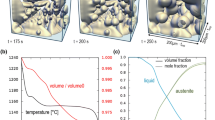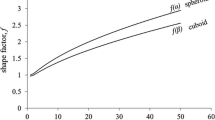Abstract
The paper deals with the issue of particle growth in a two-component alloy. The particle is formed from chemical reaction products that occur at the phase boundary. A generalized mathematical model of particle growth includes diffusion equations, mass transfer equations in the boundary layer, and equations characterizing a change in the growing particle radius. The paper proposes an approach that reduces issues to the system of PDEs and ODE that describes the state of growing particle. This approach provides a basis for developing a numerical method for calculating the growing particle radius as a function of time, based on the obtained equations. The computational scheme involves the finite-difference analogues of equations with an additional regularizing functional that ensure method stability with respect to accumulated computational error. In order to verify reliability of the proposed computational scheme and to obtain experimental error estimates of numerical solutions, computational experiments were carried out. In the experiments, the growing particle radius is determined with respect to the time via the proposed method. Also, comparative analysis of the calculated radius with test values was carried out and experimental estimates of deviations of the calculated radius from the test functions were obtained. The experiment results presented in the work indicate sufficient accuracy of the developed numerical method.

Similar content being viewed by others
REFERENCES
Kolmogorov, A.N., Statistical theory of metals crystallization, Izv. Akad. Nauk SSSR,Ser. Matem., 1937, vol. 1, no. 3, pp. 355–359.
Avrami, M., Granulation, phase change, and microstructure kinetics of phase change III, J. Chem. Phys., 1941, vol. 9, no. 2, pp. 177–184.
Volmer, M., Kinetik der Phasenbildung, Dresden, 1939.
Shneidman, V.A. and Goldstein, E.V., Nucleation time lag at nano-sizes, J. Non-Cryst. Solids, 2005, vol. 351, no. 8, pp. 1512–1521.
Wang, D., Liu, Y., Han, Y., Zhang, Y., and Gao, Z., Kinetic consideration for the incubation of the phase transformation and its application to the crystallization of amorphous alloy, Appl. Phys. A, 2008, vol. 92, no. 3, pp. 703–707.
Drozin, A.D., Gamov, P.A., Dudorov, M.V., and Roshchin, V.E., Model for nanocrystal growth in an amorphous alloy, Russ. Metall. (Engl. Transl.), 2012, vol. 2012, no. 11, pp. 1002–1005.
Drozin, A.D. and Yaparova, N.M., Probabilistic-statistical testing method for the techniques of metallographic determination of the amount of non-metallic inclusions in metal, Chern. Met., 2018, no. 8, pp. 19–22.
Lipinski, T. and Wach, A., Size of non-metallic inclusions in high-grade medium carbon steel, Arch. Foundry Eng., 2012, vol. 14, no. 4, pp. 55–60.
Belyaev, I.V., Grigorovich, K.V., Kol’chugina, N.B., and Shibaev, S.S., Effect of the purity of starting materials on the structure and properties of permanent magnets, Inorg. Mater., 2010, vol. 46, no. 3, pp. 291–294.
Sadovskii, V.M., Equations of the dynamics of a liquid crystal under the influence of weak mechanical and thermal perturbations, AIP Conf. Proc., 2014, vol. 1629, pp. 311–318.
Kholpanov, L.P. and Prokudina, L.A., Mathematical modeling of unstable mass transfer complicated by chemical reactions, Theor. Found. Chem. Eng., 2005, vol. 39, no. 1, pp. 36–46.
Izmail-Zadeh, A.T., Korotkii, A.I., Naimark, B.M., and Tsepelev, I.A., Three-dimensional numerical simulation of the inverse problem of thermal convection, Comput. Math. Math. Phys., 2003, vol. 43, no. 4, pp. 587–599.
Prokudina, L.A., Nonlinear development of the Marangoni instability in liquid films, J. Eng. Phys. Thermophys., 2016, vol. 89, no. 4, pp. 921–928.
Tikhonov, A.N., Goncharskii, A.V., Stepanov, V.V., and Yagola, A.G., Chislennye metody resheniya nekorrektnykh zadach (Numerical Methods for Solution of Incorrect Problems), Moscow: Nauka, 1990.
Vabishchevich, P.N. and Samarskii, A.A., Finite-difference schemes for convection-diffusion problems on irregular meshes, Comput. Math. Math. Phys., 2000, vol. 40, no. 5, pp. 692–704.
Frąckowiak, A., Botkin, N.D., Cia̷lkowski, M., and Hoffmann, K.-H., A fitting algorithm for solving inverse problems of heat conduction, Int. J. Heat Mass Transfer, 2010, vol. 53, nos. 9–10, pp. 2123–2127.
Yaparova, N.M. and Shestakov, A.L., Method for temperature measuring inside a cylindrical body based on surface measurements, Proc. 14th IMEKO TC10 Workshop on Technical Diagnostics 2016 “New Perspectives in Measurements, Tools and Techniques for Systems Reliability, Maintainability and Safety,” Budapest: Int. Meas. Confed., 2016, pp. 8–12.
Vasil’ev, V.V., Vasilyeva, M.V., and Kardashevsky, A.M., The numerical solution of the boundary inverse problem for a parabolic equation, AIP Conf. Proc., 2016, vol. 1773, no. 1, art. ID 100010.
Lukyanenko, D.V., Shishlenin, M.A., and Volkov, V.T., Solving of the coefficient inverse problems for a nonlinear singularly perturbed reaction-diffusion-advection equation with the final time data, Commun. Nonlinear Sci. Numer. Simul., 2018, vol. 54, pp. 1339–1351.
Samarskii, A.A., Vvedenie v teoriyu raznostnykh skhem (Introduction to the Theory of Different Schemes), Moscow: Nauka, 1971.
Funding
This work was financially supported by the Ministry of Science and Higher Education of the Russian Federation as a part of the basic part of the State task “Development, Research and Implementation of Algorithms for Processing Data of Dynamic Measurements of Spatially Distributed Objects,” TS 8.9692.2017/8.9 from February 17, 2017.
Author information
Authors and Affiliations
Corresponding author
Additional information
Translated by Sh. Galyaltdinov
About this article
Cite this article
Yaparova, N.M. Method for Determining Particle Growth Dynamics in a Two-Component Alloy. Steel Transl. 50, 95–99 (2020). https://doi.org/10.3103/S0967091220020114
Received:
Revised:
Accepted:
Published:
Issue Date:
DOI: https://doi.org/10.3103/S0967091220020114




